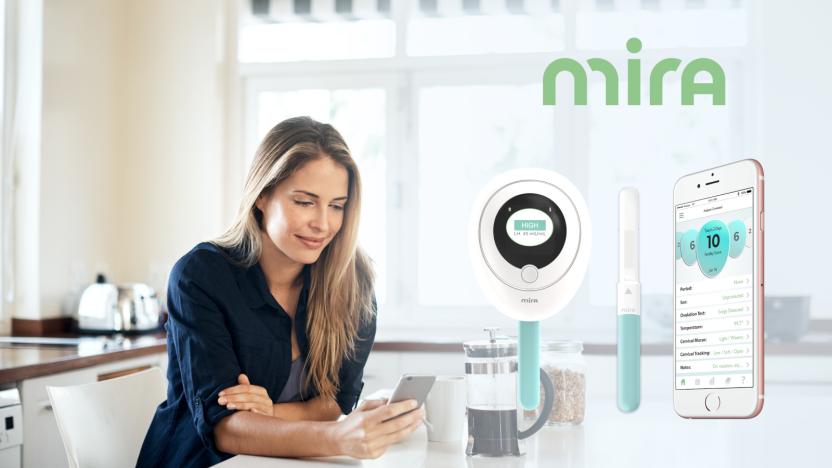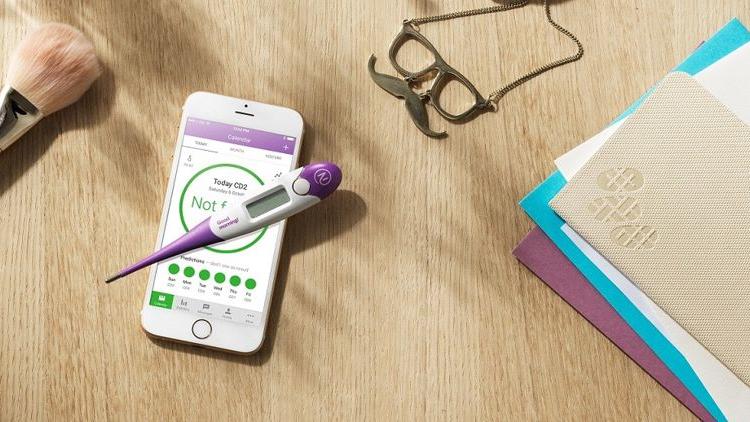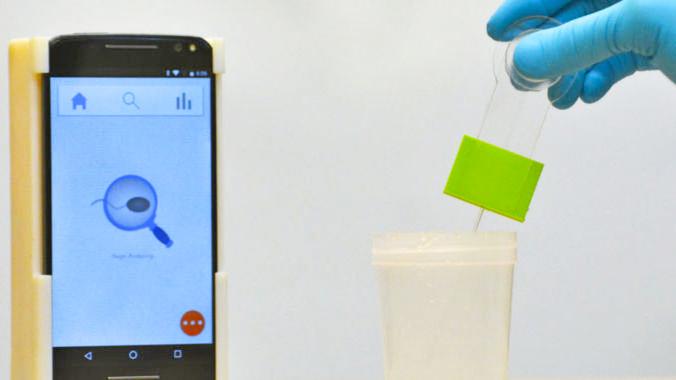fertility
Latest

This $99 'smart case' records when you take your birth control pill
The new Emme Smart Case records when you take your birth control pill and automatically updates the companion app.

Test tube embryo transfer may give near-extinct rhinos a second chance
Lab-made embryos are one step closer to saving a virtually extinct species. Scientists have successfully transferred a test tube rhino embryo back into a female for the first time, implanting the creation into a southern white rhino in Poland. The effort supports a theory that scientists can repopulate the near-extinct northern white rhino by fertilizing eggs from the two remaining animals in the species (both females that can't bear children) using frozen sperm from since-deceased males, with southern rhinos serving as surrogate mothers.

Mira's AI-powered fertility monitor is now available for purchase (update)
A company called Mira showed off its fertility monitor at CES earlier this year with the promise that it's much more accurate than the other digital trackers out there. Now, the technology is finally available for purchase worldwide. Mira's Fertility Starter kit comes with an AI-powered egg-shaped analyzer and 10 disposable test wands. Unlike the trackers that only tell you if you're ovulating or not, Mira tells you the quantity of Luteinizing hormone (LH) in your urine, which means you can use it to determine your peak fertility days. You only have to pee on a wand and stick it into the monitor to get your results.

Researchers grew a fully mature human egg in a lab
Researchers in the UK and the US have taken human eggs in their most early stage and developed them to maturity in a lab for the first time. It's a big achievement that could open up new avenues for infertility treatment and give scientists a better understanding of how the egg development process works and how it can go wrong. While this has been done before in mice, experiments of which have resulted in live offspring, this is the first time it has been done with human eggs.

Scientists get closer to replicating human sperm
Scientists have taken an important step forward in recreating the way the human body makes sperm, which could one day mean creating artificial sperm and eggs for infertility treatment. The researchers, from the University of Cambridge's Gurdon Institute, are thought to be the first team to have reached the "halfway point" -- a significant milestone -- on the path between stem cells and immature sperm.

Sperm microscope may help nanobots navigate human bodies
Scientists have developed a microscope that allows them to track sperm movements in 3D, which could benefit the understanding of both fertility treatment and micro-robotics. The device is made up of inexpensive components including LEDs and an image sensor -- like the one found in a mobile phone -- and uses holography and image reconstruction algorithms to precisely track the motion of sperm heads and tails.

Natural Cycles says contraceptive app is more effective than the pill
Contraceptive app Natural Cycles is more effective than the pill, according to the latest and largest study into the app's efficacy. After testing 22,785 women throughout 224,563 menstrual cycles, the startup found the app provided 99 percent contraceptive effectiveness if used perfectly. If used "typically", the app was 93 percent effective. The contraceptive pill, meanwhile, is 91 percent effective.

Researchers make super-cheap smartphone sperm test
Harvard researchers have developed a new device that helps men easily measure their fertility at home with their smartphone. While similar test kits exist, what sets this prototype apart is its affordability. Costing just $4.45 to make, this impressive prototype takes less than five seconds to test your little swimmers, analyzing their count and ability to swim with 98 percent accuracy.

Semen, centrifuges and a personal journey in male fertility
In August 2012, I came into a neon-pink shot glass. Nine months later, a baby was born. I'd never planned on having a child of my own -- and to be clear, I still don't -- but when two of my best friends started looking for a donor, I jumped on the opportunity. For those of us who can't have children with our partners through good old-fashioned sex, the path to pregnancy is complicated and expensive. After careful consideration, my friends decided on what's commonly referred to as the Turkey Baster Method. I would masturbate into a sterile collection cup and pass the resulting semen to my friend who would draw it into a syringe and deliver it to his wife. She would then plunge it into her vagina.

Trak's at-home sperm tracker is a surprisingly good idea
Sitting in a fertility clinic is a nerve-racking experience, and it can get even more awkward for men when they're put on the spot to produce semen samples. Fortunately for them, a new device that started shipping earlier this month can help make part of that process easier and more comfortable. It's a $200 system called Trak that not only lets you measure your sperm count in the privacy of your own home, but also teaches you how to improve your reproductive health.

Cue measures vitamin D and fertility, brings lab testing to your home
Wearables like FitBit and the Jawbone UP have encouraged our love of personal statistics, but they're currently limited to steps taken, distance walked and a handful of other relatively simple metrics. And while some gadgets can monitor your heart rate, what about things like inflammation and vitamin D levels? Enter Cue, a 3-inch device that specializes in measuring these and several other stats, including testosterone levels and influenza. It's available for a special pre-order price of $149 starting today, and it's expected to ship in spring 2015 under the FDA's investigational devices exemption. That's a long way away, but as someone who hates the doctor's office, I'm intrigued by the idea of bringing lab tests into the home. Jump past the break for a closer look.

Shocker! Laptops placed on laps will overheat you where you don't want to be overheated
Scrotal hyperthermia -- even its name sounds like a terrible, horrible thing. Yes, gadget enthusiasts, we're talking about the vastly underrated problem that is the overheating of a techie gentleman's reproductive parts. A study recently published in the Fertility and Sterility journal confirms what we've long known -- that heat escaping laptops sat on laps can and will raise the temperature in your external offspring storage units -- but adds a bit of handy additional info as well. Firstly, it turns out that keeping one's legs together to balance the laptop is mostly to blame, as it doesn't provide enough airflow to let heat escape, while lap pads have been found to be entirely ineffective in protecting testicles from rising in temperature. Another note of import is that the men in this study failed to notice when their scrotal thermometers rose above what's considered safe, so we'd just advise doing your mobile blogging Engadget style: from a bar, a coffee table, the trunk of a car, or even a humble desk.

Considering parenthood? There's an app for that
In just a few days, a UK couple will welcome their "iPhone baby." After three years of unsuccessful attempts at pregnancy, the couple downloaded an unnamed fertility calculator app. The mother-to-be, who wishes to remain anonymous, entered her temperature and other information daily. The app then did the necessary calculations to determine when she'd be most fertile. Just two months later, the couple had a little one on the way. Since the Telegraph story doesn't name the app the couple used, we've gathered a few with similar functionality: Fertility and Pregnancy Calculator [iTunes link] Much like the app in the story, this one will help a woman determine when she's most fertile. After that, she can use it to track Jr.'s development. Free. iFertility [iTunes link] iFertility helps women track their Basal Body Temperature and adds an option to share logs with her doctor either via the app or email. $1.99 Fertility Foods [iTunes link] This ebook for the iPhone and iPod touch by Dr. Jeremy Groll presents a diet-based method of increasing ovulation and getting pregnant. Dr. Groll is an OB/GYN specializing in the treatment of infertile couples. This book is an Iceburg Reader book, which are very well done. $15.99 A Barry White album wouldn't hurt, either. As a parent of toddlers, I get much use out of Pocket God [iTunes link], which my 6-year-old loves, PicPosterous [iTunes link] for uploading snapshots to a family gallery and Pickin' Time [iTunes link], which both the 6-year-old and 5-year-old love. We even used Ambiance [iTunes link] for my son when we left his white noise machine at home while on vacation. Last week an iPhone app helped save a life, and this week it helped create one. The tablet better have some REAL magic up its sleeve in order to top that.

DuoFertility skin patch keeps watch on ovulation
It's been quite a while since we've seen any significant advances in ovulation monitoring technology, but this new DuoFertility skin patch looks set to shake things up a bit, with it taking an always-on approach to keeping tabs on your (or your significant other's) fertility status. That's done with the help of a patch worn under the arm, which continuously monitors basal body temperature and can be read at any time in just a few seconds with the aid of the reader (pictured above). If you need a bit more information, you can then plug the reader into your PC and get your fertility status in chart and graph form. No word on a release 'round these parts just yet, but those in Europe will apparently be able to pick 'em up "later this year" for $1,000 apiece.[Via Coolest Gadgets]

Samsung files patent app for fertility measuring phone
Believe it or not, we've seen something like this before -- out of Japan, naturally -- so we're a bit surprised to see a patent app roll in from Samsung for a phone capable of tracking a woman's fertile periods. The idea is to keep the user updated on her "baby" and "no baby" times of the month when she places a call by measuring distance to the eardrum (using either ultrasonic or laser sensors) combined with infrared to get a temperature reading. This corresponds to a woman's basal body temperature cycle, which in turn maps to her menstrual cycle. In Japan, the concept was intended to boost birth rates by keeping couples in the know on exactly when they might have success -- but elsewhere we imagine the intent might be just the opposite. We'll leave it to our readers' active imaginations to decide just when and how the user should be kept abreast of said information.[Via Unwired View]

Falling birth rates? NTT DoCoMo has the answer
If there's two thing we know Japan has, it's a steadily declining birth rate and insanely advanced mobile technology. Doesn't it seem like one could be used to solve the other? (No?) Leave it to the good folks at NTT DoCoMo to have a crack at it, releasing the new D702iF FOMA clamshell from Mitsubishi. It seems innocent enough, but a few keystrokes allows the user to track his or her (hopefully her) menstrual cycle and be notified during the most fertile times of the month. The somewhat unusual function, along with the phone's bullet-shaped design and pastel colors, are the brainchild of Japanese designer Momoko Ikuta. The decidedly feminine phone also features a built-in recipe database (which we hear features a mean white bean chicken chili) and a "camouflage melody" function -- a fancy way of describing a fake ring for those times when you want to completely ignore the people around you.[Via CNET]

The new Baby Boom fertility watch from Laks
As much as we love to integrate superfluous technology into our everyday doings, we've gotta say that this new "Baby Boom" fertility wristwatch from techno-watch extraordinaire Laks has us just a little bit creeped out. Maybe it's the concept of a cold little digital device helping out with tracking fertile days, pregnancy weeks and finding baby names, or the fact that the watches look decidedly man-ish, but whatever it is, Laks seems to have packed in some hefty fertility-centric capabilities -- and we're just not sure how we feel about that. Anyways, we're guessing the black and grey watch is a sort of "him and hers" setup, since they're sold in a two pack for 149 Euro ($189 US), while a single watch goes for 90 Euro ($114 US). They should be shipping now.











